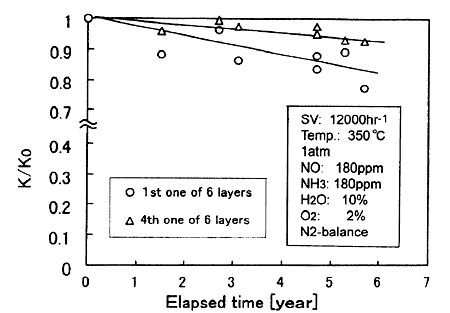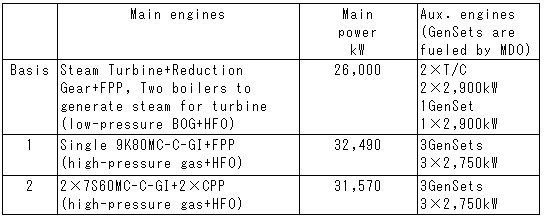
Fig.10 Deterioration of Catalyst
The K/K0 of 1st layer catalyst and 4th layer catalyst after about 6 year service are 0.77 and 0.93, respectively. The deactivation of the catalyst in the upper stream is faster than the one in the middle stream. The deactivation seems to develop K/K0 linearly with time elapsed. According to N2-BET, the specific surface area of catalyst has decreased to 1/3 in case of 1st layer, and 1/2 in case of 4th layer. The pore volume of the catalyst is found to be almost unchanged, which altogether may suggest growth of pore size in this period.
It is found from the chemical analysis that neither deactivation due to deposit of Ca-component (derived from lubricating oil) nor due to the deposit of S-component (derived from fuel oil) has taken place, and furthermore that deposit of the poison material Na has not taken place. The reason for the deactivation might be loss of surface area by heat, for example calcination3), not poison4), not masking4).
It is concluded that the deactivation of the catalyst in the upper stream is faster than the one in the middle stream of the SCR tower of GIDE, and that the influence of high pressure on the deactivation of the catalyst is small in the SCR system of GIDE.
5. Comparative study of propulsion alternatives for LNG carriers
The satisfactory service experience from the Chiba GIDE plant and the current development obliges us to reconsider the propulsion of future LNG carriers, taking a wider perspective than the conventional system with steam turbines. The dual fuel types of diesel engines are able to utilise natural gas in combination with liquid fuels, the latter ranging from heavy fuel oil to light fuel oil and in different proportions. In case of the Chiba GIDE, low sulphur diesel oil is used from an environmental point of view.
Both 2- and 4-stroke diesel engines can be used for the propulsion of LNG carriers, however for the simplicity we select only 2-stroke diesel engine for comparison. The comparison of the three propulsion systems for the popular 135,000 m3 volume LNG carriers are shown in Table 4.
Table 4 Comparison of the Three Propulsion Systems

The comparative analysis of the propulsion options should be made based on the following factors:
・First cost
・Fuel consumption
・Ease of maintenance
・Lube oil consumption, etc.
・Total operating costs
・Reliability
・Redundancy
・Service experience
First cost is a rather difficult item to compare, however, by far the most popular 2-stroke low speed diesel engines in marine propulsion and also the great simplicity of the installation of the low speed engines are reflected in the first cost, which is significantly less than that of competitors. Total first cost of alternative 1 and 2 are less than 80% of that of the steam turbine.
Fuel consumption: Improved insulation of the gas tanks has reduced the BOG amount, and a large amount of HFO has to be used. This reduction (compared to older vessels) of BOG available for propulsion means that an extra amount of HFO is needed, especially for long distance voyage. The better efficiency of the diesel engine compared to the steam turbine makes the diesel alternative more logical for use today in propulsion plants for LNG carriers. Fuel oil costs (HFO + MDO) per year of alternative 1 and 2 are less than 50% of that of steam turbine.
Maintenance: In spite of the steam turbine's requirement for highly qualified man power, the steam turbine is the cheapest in maintenance in this comparison. The maintenance costs estimated for 2-stroke engines are higher for a twin screws plant because of more cylinders. On the other hand, the twin screws plant ensures that maintenance can be carried out without off-hire (because one engine can be stand-by during maintenance of the other, thus the vessel is not immobilised).
However, since the absolute maintenance cost is only around 1% of the first cost, the influence is small.
Lube oil consumption and other minor costs: The steam turbine is less expensive in this respect and the diesel engines are the most expensive. However again the absolute figures are nearly same as that of maintenance costs.
The total operating costs consist of fuel costs + lube oil costs + maintenance cost + others. The result shows that the 2-stroke solution is the least expensive and below 70% of that of the steam turbine as shown in Table 5.
BACK CONTENTS NEXT